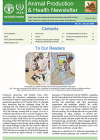The intensification of livestock production systems is a prerequisite to meet the growing demand for animal products. Genetic selection, assisted reproductive technologies and optimized reproduction involving nuclear and nuclear-derived technologies support the production of animals that are more productive while retaining their ability to cope in harsh environments.
Reproduction and breeding
In the past, livestock productivity was primarily increased by introducing foreign, high-producing breeds, often from temperate into tropical countries. This has not always been successful as these breeds were more susceptible to diseases than local animals and were poorly adapted to local environments.
Improving native breeds through genetic selection in such a way that they retain their adaptability to local environments and their often innate tolerance to local diseases is crucial in addressing the challenge of supplying a persistently growing demand for food of animal origin. Various nuclear and nuclear-derived technologies exist to support such genetic selection procedures.
Jointly with the FAO, the IAEA assists Member States to develop and adopt such technologies to optimize livestock reproduction and breeding practices, supporting the intensification of animal production and the optimal utilization of natural resources.
Genomic data helps improve breeding
Improving livestock productivity is strongly linked to the need to preserve the huge diversity of animal genetic resources. Different species and breeds are able to adapt in often very distinctive ways to extreme environmental conditions, such as drought, humidity, cold or heat, and are often resistant to locally prevailing diseases. However, there is often a lack of proper animal identification, of information on genetic potential and of systems to record and analyse performance data, in particular in developing countries. To counter these challenges, it is crucial to generate genomic data of performance recorded animals, as this enables breeders and farmers to relate production traits with parentage and genetic admixture of animals, thereby allowing them to identify and select superior sires for breeding.
In many of those countries, there is also a need to develop state-of-the-art artificial insemination and other assisted reproductive technologies, similar to those used in developed countries. This includes stud management, production of high quality semen and embryos, and optimized methodologies for delivering quality breeding services to farmers. All this requires an in-depth understanding of reproductive physiology.
How nuclear and isotopic techniques can contribute
Radioimmunoassay (RIA) of hormones in milk, blood and other body fluids using iodine-125 is a mature and often used nuclear technique that can be easily performed in decentralized laboratories. It provides unique support in improving outcomes of artificial insemination services. Several nuclear-derived enzyme-linked immunosorbent assay (ELISA) kits have been developed, using the RIA as a standard, and are now commercially available, also as mobile, cow-side test kits.
Irradiation with cobalt-60 is used to construct radiation hybrid panels for the mapping of livestock genomes. High resolution radiation hybrid maps facilitate genome assembly by correctly ordering genes and genetic markers along chromosomes. An entire high resolution genome radiation hybrid map has been completed for goats and is now being generated for camels.
Radioisotope based detection of biomarkers is used in the validation of techniques for early pregnancy diagnosis in bovine animals; and novel nucleic acid markers are sequenced using fluorescence, sulfur-35 or phosphorus-33 labelled nucleotides.






